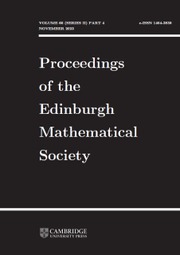Article contents
On some generalisations of Laguerre polynomials
Published online by Cambridge University Press: 20 January 2009
Extract
Let  , (n = 0, 1, ….) be the Laguerre, Hn(x) the Hermite polynomial. Let
, (n = 0, 1, ….) be the Laguerre, Hn(x) the Hermite polynomial. Let  , be the space of all functions f(x) the pth powers of which are integrable over (a, b), with the norm
, be the space of all functions f(x) the pth powers of which are integrable over (a, b), with the norm

- Type
- Research Article
- Information
- Proceedings of the Edinburgh Mathematical Society , Volume 6 , Issue 3 , August 1940 , pp. 135 - 146
- Copyright
- Copyright © Edinburgh Mathematical Society 1940
References
1. Banach, S.Theéorie des opérations linéaires (Warszawa, 1932), 58, théorème 7Google Scholar, Kaczmarz, S. and Steinhaus, H., Theorie der Orthogonalreihen (Warszawa-Lwów, 1935),Google Scholar [625] and [624]. There the theorem is proved for a finite interval, but it is also true for an infinite one, since the well known theorem [1.71] on moments is also valid for an infinite interval.
The theorem is also valid for complex-valued functions.
2. CfKaczmarz-Steinhaus, Google Scholar, I. c. This book contains a proof, page 280 et seq., but Kaczmarz's definition of a complete system is different from that used here. In order to apply their general theorem [874] on Laguerre polynomials, the condition n −1υ(nq)1/(nq) → 0, (n→ ∞, q = 1/p′), has to be replaced by
Then the theorem covers the completeness of ![]() in the cases 1 < p< ∞
in the cases 1 < p< ∞
3. Kober, H., Quart. J. of Math. (Oxford) 8 (1937), 186–99. Full details are given in the sixth section of the present paper.Google Scholar
4. Watson, G. N.Proc. London Math. Soc. (2), 35 (1933), 156–99.CrossRefGoogle ScholarBusbridge, I. W.Journal London Math. Soc. 9 (1934), 179–87.CrossRefGoogle Scholar
5. We can obtain the proof of this lemma by following the lines of the proof [483] given by Kaczmarz-Steinhaus. Let 0 < b < c, h(t) = ebt g(t) then (i) and (ii) imply g(t) ∈ £(0, ∞), h(t) ∈(0, ∞). The function
is regular for ![]() ; and for, |s| < b,
; and for, |s| < b,

Therefore for, |s| < b,
Hence F(s) vanishes for ![]() , and by Lerch's theorem so also doges g(x).
, and by Lerch's theorem so also doges g(x).
6. CfKaczmarz-Steinhaus, , 1. c. [874] the proof covers the cases 1<p<∞ Here I outline another proof.Google Scholar
7. Kober, H., I. c.Google Scholar
8. Quart. J. of Math. (Oxford), 9 (1938), 196–8.Google Scholar
9. When J. ≦ 0 Cf. Szegö, G., Math. Zeitschrift, 25 (1926), 87–115.CrossRefGoogle Scholar
10. Kober, H., Annals of Math., 40 (1939), 549–59.CrossRefGoogle Scholar
11. Originally we deduced (6.7) for j≦0, from the properties of the operator ![]() with which we have already dealt in a former paper, Quart. J. of Math. (Oxford), 10 (1939), 45–59. The assertion stated on page 52, line 19–21, is untrue in general; when r = ½ it can be replaced by some results given in this paper. The operator F8 has also been dealt with in that paper.Google Scholar
with which we have already dealt in a former paper, Quart. J. of Math. (Oxford), 10 (1939), 45–59. The assertion stated on page 52, line 19–21, is untrue in general; when r = ½ it can be replaced by some results given in this paper. The operator F8 has also been dealt with in that paper.Google Scholar
- 1
- Cited by


